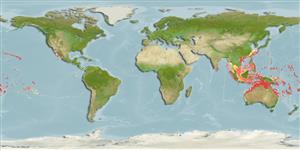Environment: milieu / climate zone / depth range / distribution range
Ecología
marino asociado a arrecife; no migratorio; rango de profundidad 0 - 120 m (Ref. 1602). Tropical; 30°N - 33°S
Pacific Ocean: Ryukyu Islands to the Philippines and extending to Lord Howe, Rapa and Tuamoto islands. Replaced by Chaetodon madagascariensis in the Indian Ocean, Chaetodon xanthurus in southeast Asia, and Chaetodon paucifasciatus in the Red Sea (Ref. 37816).
Tamaño / Peso / Age
Maturity: Lm ? range ? - ? cm
Max length : 12.5 cm TL macho / no sexado; (Ref. 4859)
Espinas dorsales (total): 12 - 14; Radios blandos dorsales (total): 21-23; Espinas anales 3; Radios blandos anales: 16 - 17. Body color is white with 4-5 chevron-shaped blackish bands on the sides. The posterior portion of the trunk, the adjacent dorsal and anal fins, and the posterior portion of the caudal fin are yellow. A vertical black bar runs (uninterrupted) across the eye (Ref. 4855). Snout length 2.3-3.0 in HL. Body depth 1.7-1.8 in SL (Ref. 90102).
Inhabit deep lagoons and seaward reefs. Occur singly or in pairs. Feed on algae and small benthic invertebrates (Ref. 1602). Oviparous (Ref. 205). Form pairs during breeding (Ref. 205). May hybridize with C. xanthurus. Minimum depth reported taken from Ref. 128797.
Life cycle and mating behavior
Madurez | Reproducción | Puesta | Huevos | Fecundidad | Larva
Distinct pairing (Ref. 205).
Myers, R.F., 1991. Micronesian reef fishes. Second Ed. Coral Graphics, Barrigada, Guam. 298 p. (Ref. 1602)
IUCN Red List Status (Ref. 130435)
Threat to humans
Harmless
Human uses
Pesquerías: escaso valor comercial; Acuario: Comercial
Más información
ReferenciasAcuiculturaPerfil de acuiculturaRazasGenéticaElectrophoresesheritabilidadEnfermedadesProcesamientoNutrientsMass conversion
Herramientas
Special reports
Download XML
Fuentes de Internet
Estimates based on models
Preferred temperature (Ref.
123201): 23.7 - 28.4, mean 26.8 °C (based on 202 cells).
Phylogenetic diversity index (Ref.
82804): PD
50 = 0.5000 [Uniqueness, from 0.5 = low to 2.0 = high].
Bayesian length-weight: a=0.02239 (0.01427 - 0.03512), b=3.24 (3.11 - 3.37), in cm total length, based on LWR estimates for this species & Genus-body shape (Ref.
93245).
Nivel trófico (Ref.
69278): 3.0 ±0.41 se; based on food items.
Resiliencia (Ref.
120179): Alto, población duplicada en un tiempo mínimo inferior a 15 meses (Preliminary K or Fecundity.).
Fishing Vulnerability (Ref.
59153): Low vulnerability (10 of 100).
Nutrients (Ref.
124155): Calcium = 125 [63, 193] mg/100g; Iron = 0.954 [0.566, 1.634] mg/100g; Protein = 18.4 [17.2, 19.6] %; Omega3 = 0.135 [0.077, 0.235] g/100g; Selenium = 45.7 [23.5, 87.5] μg/100g; VitaminA = 44.8 [12.0, 164.6] μg/100g; Zinc = 1.68 [1.13, 2.46] mg/100g (wet weight);
